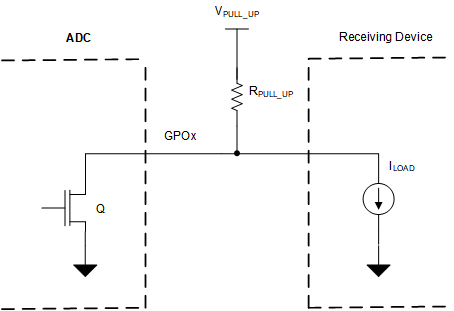SBAS961A May 2019 – April 2020 TLA2528
PRODUCTION DATA.
- 1 Features
- 2 Applications
- 3 Description
- 4 Revision History
- 5 Pin Configuration and Functions
- 6 Specifications
-
7 Detailed Description
- 7.1 Overview
- 7.2 Functional Block Diagram
- 7.3 Feature Description
- 7.4 Device Functional Modes
- 7.5 Programming
- 7.6
TLA2528 Registers
- 7.6.1 SYSTEM_STATUS Register (Address = 0x0) [reset = 0x80]
- 7.6.2 GENERAL_CFG Register (Address = 0x1) [reset = 0x0]
- 7.6.3 DATA_CFG Register (Address = 0x2) [reset = 0x0]
- 7.6.4 OSR_CFG Register (Address = 0x3) [reset = 0x0]
- 7.6.5 OPMODE_CFG Register (Address = 0x4) [reset = 0x0]
- 7.6.6 PIN_CFG Register (Address = 0x5) [reset = 0x0]
- 7.6.7 GPIO_CFG Register (Address = 0x7) [reset = 0x0]
- 7.6.8 GPO_DRIVE_CFG Register (Address = 0x9) [reset = 0x0]
- 7.6.9 GPO_VALUE Register (Address = 0xB) [reset = 0x0]
- 7.6.10 GPI_VALUE Register (Address = 0xD) [reset = 0x0]
- 7.6.11 SEQUENCE_CFG Register (Address = 0x10) [reset = 0x0]
- 7.6.12 CHANNEL_SEL Register (Address = 0x11) [reset = 0x0]
- 7.6.13 AUTO_SEQ_CH_SEL Register (Address = 0x12) [reset = 0x0]
- 8 Application and Implementation
- 9 Power Supply Recommendations
- 10Layout
- 11Device and Documentation Support
- 12Mechanical, Packaging, and Orderable Information
パッケージ・オプション
メカニカル・データ(パッケージ|ピン)
- RTE|16
サーマルパッド・メカニカル・データ
- RTE|16
発注情報
8.2.1.2.2 Digital Open-Drain Output
The channels of the TLA2528 can be configured as digital open-drain outputs supporting an output voltage up to 5.5 V. An open-drain output, as shown in Figure 48, consists of an internal FET (Q) connected to ground. The output is idle when not driven by the device, which means Q is off and the pull-up resistor, RPULL_UP, connects the GPOx node to the desired output voltage. The output voltage can range anywhere up to 5.5 V, depending on the external voltage that the GPIOx is pulled up to. When the device is driving the output, Q turns on, thus connecting the pull-up resistor to ground and bringing the node voltage at GPOx low.
 Figure 48. Digital Open-Drain Output
Figure 48. Digital Open-Drain Output The minimum value of the pullup resistor, as calculated in Equation 3, is given by the ratio of VPULL_UP and the maximum current supported by the device digital output (5 mA).
The maximum value of the pullup resistor, as calculated in Equation 4, depends on the minimum input current requirement, ILOAD, of the receiving device driven by this GPIO.
Select RPULL_UP such that RMIN < RPULL_UP < RMAX.